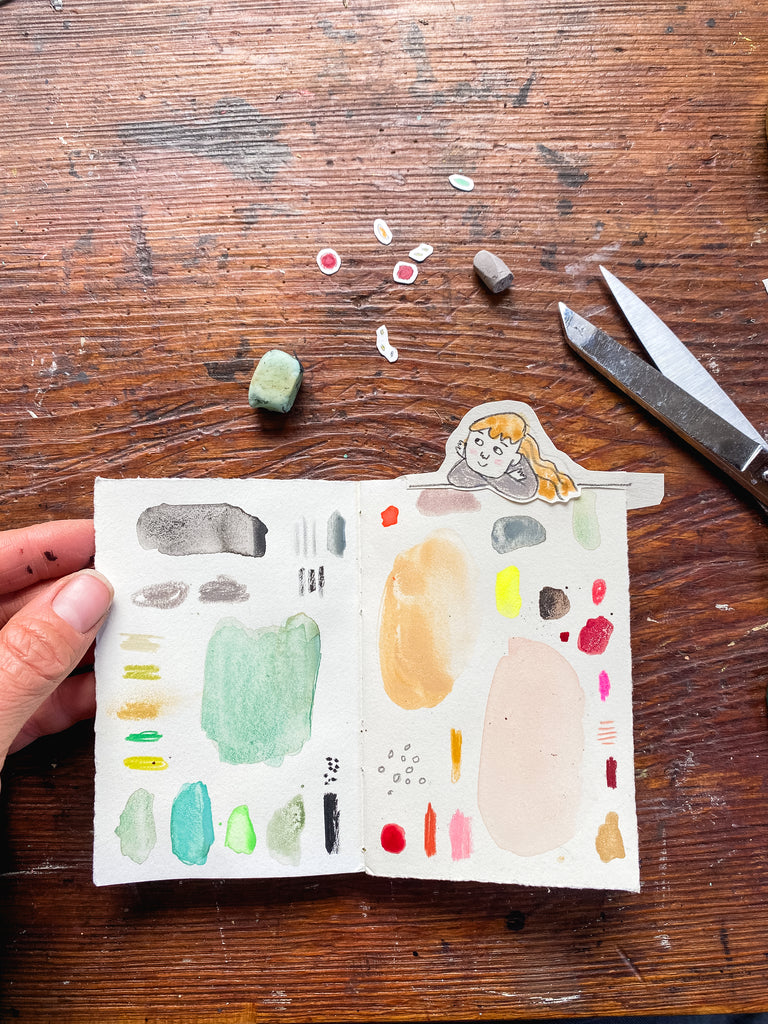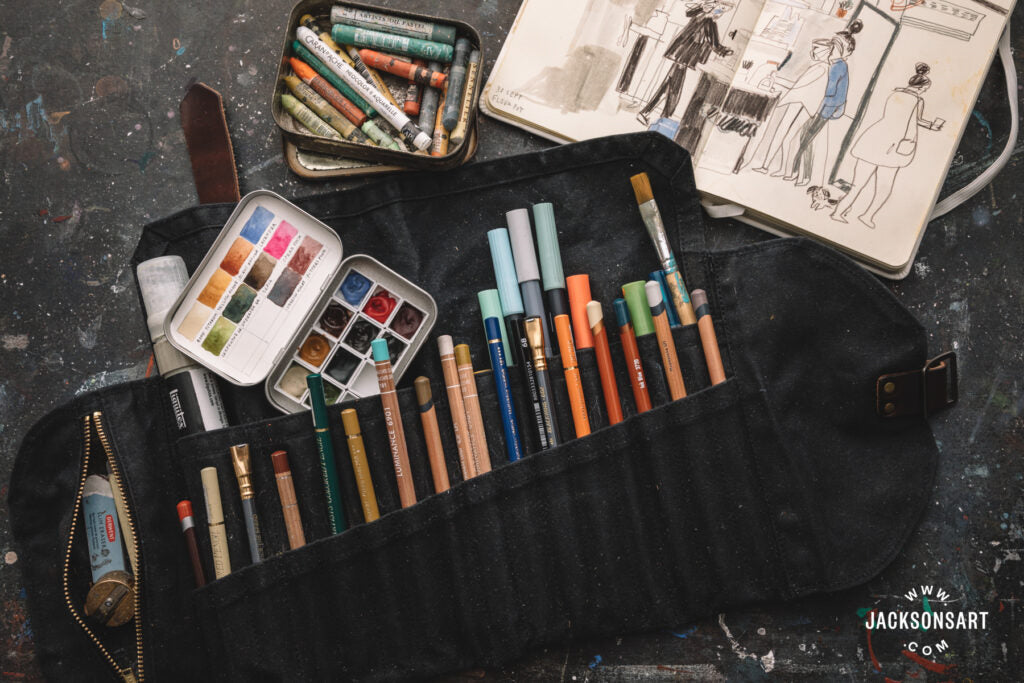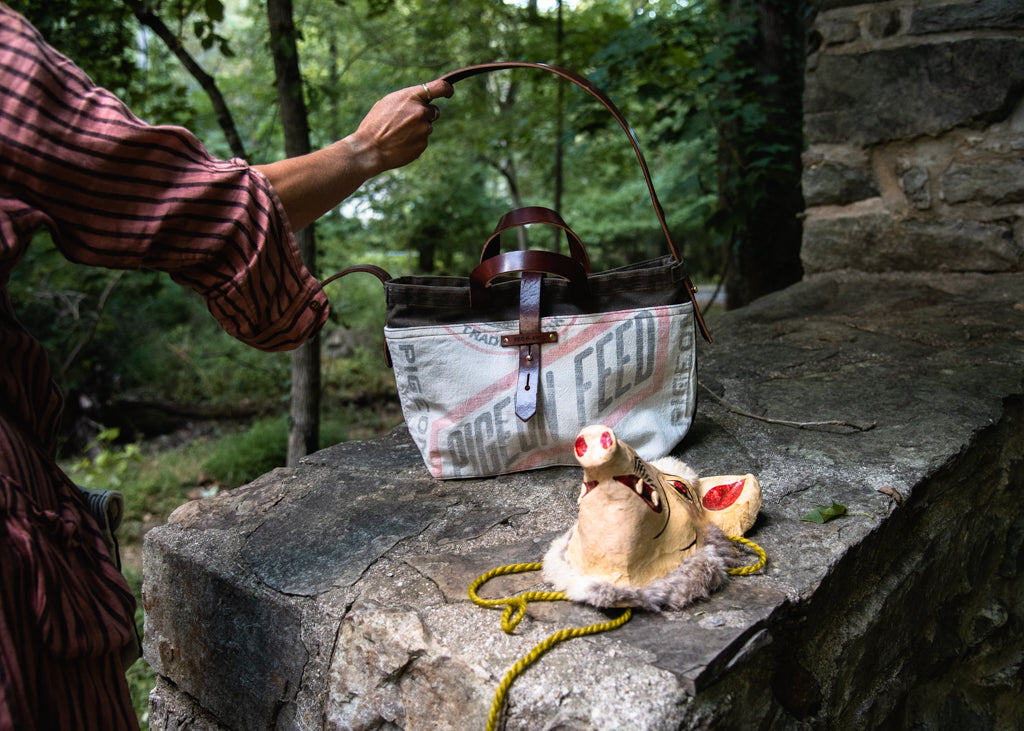Blog
-
We’ve decided to discontinue a handful of our classics – some of which have been with us from the beginning! These treasures are limited to the quantities currently on our website and ready to ship. If there is anything you’ve been wanting, now is the time to scoop it up!


“The facts are sonorous but between the facts there’s a whispering. It’s the whispering that astounds me...”
–Clarice Lispector from The Hour of the Star
Since the start of our business, we’ve been making objects that change as we change – fast, slow, it is difficult to say. Perspective is mysterious!
As we reflect on the objects we make and have made, we feel ready for change yet again, ready to make space for new objects reflective of our new experiences and environments.
We’ve decided to discontinue a handful of our classics – some of which have been with us from the beginning! These treasures are limited to the quantities currently on our website and ready to ship. If there is anything you’ve been wanting, now is the time to scoop it up!View our Last Chance treasures, here.
As always, if you have any questions, send us an email at info@pegandawlbuilt.com
Bags for All OccasionsClick here for to view all last chance treasures.


The Weekender The Large Finch Satchel 

The Large Waxed Canvas Tote The Dopp Case 

The Reader
Home and Kitchen CollectionClick here for to view all last chance treasures.


Olde-Fashioned Tree Swing Step Stool
Studio and Decoupage
Click here for to view all last chance treasures.


Chalk Pad Large Desk Caddy with Quote 

Apothecary Caddy Decoupage Collection Last Chance for these Peg and Awl Classics!
“The facts are sonorous but between the facts there’s a whispering. It’s the...
Read The Post -
Inspired by Autumn, we’ve put together a small batch of some of our favourite bags in four new colours: Elderberry, Red Maple, Birch, and Fog. We’ve also chosen Red Maple for our Sendaks! These bags are constructed with the same durable waxed canvas we love, hand-dyed with special colours, and finished with our brown or black vegetable-tanned leather! As with all of our bags, these can be personalized.


We settle into the old mill as if it were home. Søren rests against what is left of a wall and opens his sketchbook to map out a world of his own invention. Silas walks back and forth on the high edge of the wall where once was a roof, headphones on, music playing. Walter and I unpack weekenders filled with clothes, masks, and our new autumn-coloured bags. Despite the calm, we are working under the Autumn sun and have little time. Pearl stuffs her wet and twitching nose into leaf piles, exploring worlds unknown to us.
Trees drop their leaves into and around what is left of the old Mill where women once gathered and chattered whilst waiting for warm bread. Our senses are ignited out here in this sentient place – amongst beings seen and unseen. There is an abundance of things to be grateful for, our lists are never long enough.
Inspired by Autumn, we’ve put together a small batch of some of our favourite bags in four new colours: Elderberry, Red Maple, Birch, and Fog. We’ve also chosen Red Maple for our Sendaks! These bags are constructed with the same durable waxed canvas we love, hand-dyed with special colours, and finished with our brown or black vegetable-tanned leather! As with all of our bags, these can be personalized.
Elderberry

Waxed Canvas Tote The Hunter Satchel 

The Small Hunter Satchel The Keeper Pouch 

The Finch Satchel 

The Maker Pouch The Scholar Pouch
Red Maple

The Finch Satchel The Hunter Satchel


The Small Hunter Satchel Waxed Canvas Tote 

The Scholar Pouch The Maker Pouch 

The zipper pouch filled with my erasers, and sharpers. Sendak Mini Artist Roll 

The Sendak Artist Roll 4” Anselm Bookbinding Kit
Fog


Waxed Canvas Tote Mini Waxed Canvas Tote 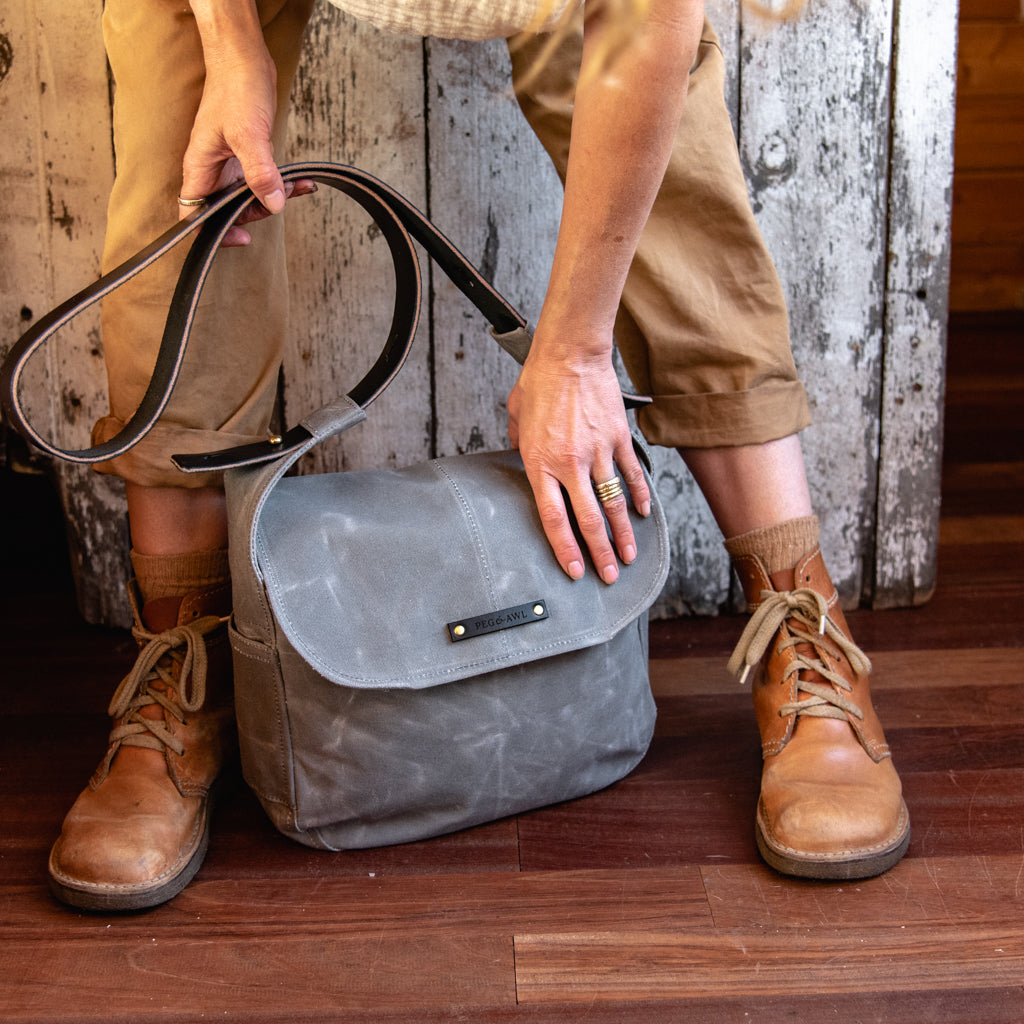

The Finch Satchel The Hunter Satchel 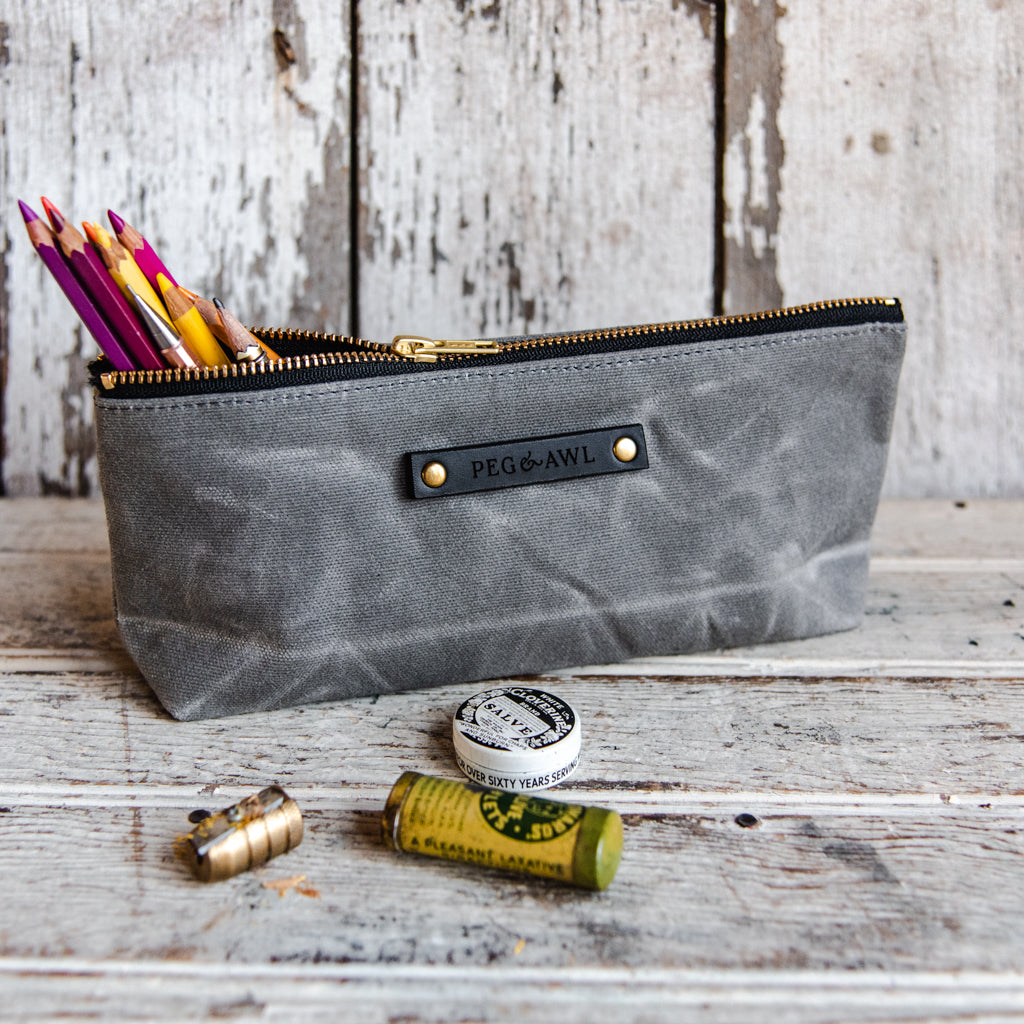

The Scholar Pouch The Keeper Pouch
Birch


Waxed Canvas Tote The Small Hunter Satchel 

The Keeper Pouch The Finch Satchel Mini Waxed Canvas Tote The Maker Pouch Our Collections Explained!
If you’ve been following along with us for a while, you may have noticed that not all launches are the same – some products stay for years, some fly off the shelves, and others fall somewhere in between. Here are some explanations to distinguish between our various collection types.
Standard Collections: Everything in our standard collections will be ongoing until we decide to stop making them! They may include some vintage or antique materials, (ex. journal fabric lining) but these details will vary subtly to ensure their ongoingness.
Small Batch Collections: Limited batches incorporating specialty or vintage materials where larger batches can be made, but are not infinite! The quantity ranges, but we aim for minimum of 100 in these collections.
Of a Kind Collections: Limited batches incorporating vintage or antique materials. Each object will be limited from 1–20 items depending upon our findings.
Small Batch of New Autumn Colours (2022)
We settle into the old mill as if it were home. Søren rests against what is ...
Read The Post -
As you may see from my list of Things I Love, I've been on a bit of a binge lately. I'm feeling a welcome change a-coming and it expresses itself through food, new adventures, new clothes, &c. (though as I reflected on last year's gift guide, I am also quite the same.)
May my list lead you down some enchanting rabbit holes!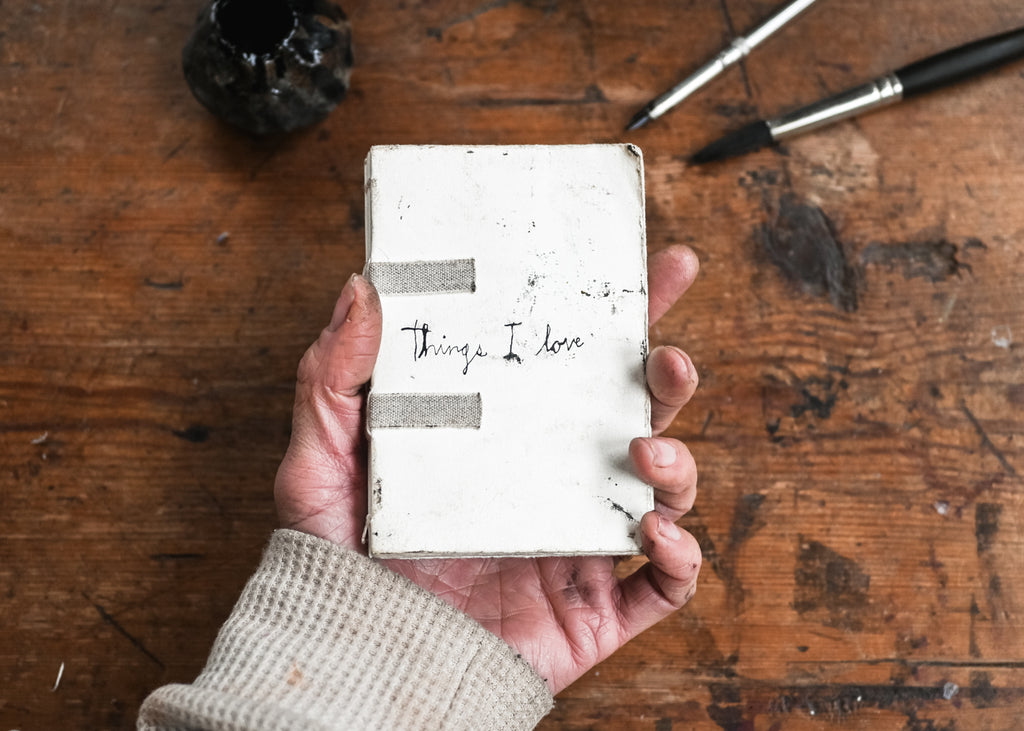

As you may see from my list of Things I Love, I've been on a bit of a binge lately. I'm feeling a welcome change a-coming and it expresses itself through new food, new adventures, new adornments, &c. (though as I reflected on last year's gift guide, I am also quite the same.)
May my list lead you down some enchanting rabbit holes!ps: These are drawn with my non-dominant hand:) More @beingmargauxkent


Antique Tins
I may have a habit of vintage tins. I like to say I am NOT a collector, but I do fancy myself a gatherer. I love tins for hauling art supplies, soft things like pastels, and tiny messy things like pen nibs. And they make wonderful alternative sketchbooks. They fit nicely into my Sendak and pouches. And of course, I love a good Flea Market find — though Etsy and Ebay are great resources if you are patient!Bonsai
Silas is learning about Bonsai's for a Homeschool project and he got us all into it. Our garden, artist friend Kai, brought a bag of Bonsai-able trees for Silas, including: Azalea, Boxwood, Pines, Juniper, and Hercules Club. The places to look, he said, are parking lots and mowed areas where the roots are biggened as the tops are shorn! Abundance everywhere, for those who seek it!


Always More Books
I will never stop gathering books. Unread stacks surround me, but also, many are read and scribbled and delighted in. (PS: Padraig O'Tauma's book has been long preordered - check.)The Simple Folk
I stopped at my favourite Philadelphia shop, Vagabond, and found The Simple Folk linen dress (among other things)! So cozy, layerable, pocketed, swishy, and loooong. I have to tie it in a knot to bike and hike with it — but yay! I love it so.
Mentioned in this Post:
From Our Shop:
From Other Shops:
- Nikon Zfn Mirrorless Camera
- Providence Animal Shelter
- Duckfeet Boots
- Make Ink: A Forager’s Guide to Natural Inkmaking by Jason Logan
- Gardenheir
- Warwick Furnace Farm Lavender Goods
- Bonsai
- The Simple Folk
- Spruce Tip Jelly
- Omega Juicer
- Bellwether Farm Sheep Milk Yogurt
Related Blog Posts:
2022 Gift Guide: Things I love
As you may see from my list of Things I Love, I've been on a bit of a binge ...
Read The Post -

Here are some of my favourite little and big things. I am often overwhelmed by stuff I have, stuff I want, the general problem of stuff. But I was reminded the other day how important our small businesses are – to the economy, to those around us, to the people we work with and the materials we use – this all has value that is sometimes hard to see. This got me to really appreciating some of the little treasures around me –
Above: Our very best everyday present is our Pearl! We got her from Providence Animal Center last December and not a day goes by where don’t express our gratitude in our silly voices and normal voices, for being paired with the very best doggo in the world!

Here are some of my favourite little and big things. I am often overwhelmed by stuff I have, stuff I want, the general problem of stuff. But I was reminded the other day how important our small businesses are – to the economy, to those around us, to the people we work with and the materials we use – this all has value that is sometimes hard to see. This got me to really appreciating some of the little treasures around me –
Above: Our very best everyday present is our Pearl! We got her from Providence Animal Center last December and not a day goes by where don’t express our gratitude in our silly voices and normal voices, for being paired with the very best doggo in the world!
2021 Gift Guide to some of my favourite (mostly) small business treasures!
Here are some of my favourite little and big things. I am often overwhelmed ...
Read The Post -
Last month I spent a weekend at the Warwick Furnace Farm for a much needed impromptu escape with Claire Rosen (one of the farm’s sisters) and Emma Mierop of Skippy Cotton. We planned to take our worlds apart and put them back together again; we talked and explored the lavender fields, I scribbled in my journal in this new space, we visited a nearby museum, and more.

My Warwick Weekend.
Last month I spent a weekend at the Warwick Furnace Farm for a much needed impromptu escape with Claire Rosen (one of the farm’s sisters) and Emma Mierop of Skippy Cotton. We planned to take our worlds apart and put them back together again, but we only got as far as:
Taking our worlds apart over snacks and long lavender soaked discussions,
going for a long walk on a cold, star bright night,
understanding that a thing taken apart nearly always reveals more than expected, and therefore takes longer to put back together,
and nebulous plans for a next time.I also made some pretty classic Margaux messes everywhere I went. Claire seemed unbothered. See my dribblings and droppings below:

What a treat to have a morning like this! Lavender everywhere! 

I also love my Duckfeet Boots! Piles of things on the floor. I settle in quickly... 
Pearl and Honey enjoyed their freedom and new found friendship!
Warwick Furnace Farm
Claire and her family moved to Pennsylvania and started a Lavender farm where they make a variety of Lavender Delights, host an Artist’s Retreat, have an inspiring Gallery Space, etc. In addition to their combined love of Lavender, each family member follows their own varied passions in this magical space that they’ve created. Their farm is a short, beautiful drive from us…
Here are a few photographs of Claire’s fantastical and elaborate photographed worlds – her own individual passion.
Skippy Cotton
Emma’s shop is a delight! She combines her drawings, embroidery, and whimsy to form her own House of Curiosities! From ornaments to clothing to artist supplies – have a peek into her wondrous world. She has also navigated her way into the world of AI art and has made some enviable pieces with it (another can of worms we discussed with exuberance)!


Skippy Cotton's year-round ornaments! Which of course also look splended on a Christmas Tree!
Fragile Earth Exhibit at the Brandywine River Museum
Claire surprised us with a visit!




Mark Dion Ever a favourite, Søren and I spent an especially long time with his work, chortling and sighing, and all manner of involuntary noise making...So maybe I was a little noisier than Søren. 

James Prosek We investigated James’s mysteries close enough to set off alarms – lucky for us, there weren’t any. 

Jennifer Angus An abundance of bugs and tiny stories built into boxes and wall pieces. Everyone clambered to take in as much detail as possible; no one wanted to leave. My Warwick Weekend – An Impromptu Escape with Claire Rosen and Emma Mierop
My Warwick Weekend. Last month I spent a weekend at the Warwick Furnace Fa...
Read The Post -
Sarah Dyer, one of my favorite picture book makers and illustrators, recently wrote a detailed and very informative review on our Sendak Artist Roll for the Jackson’s Art Supplies blog. She includes lots of photographs with her own art supplies, showing how she organizes them into her Sendak. It is a delight to see the Sendak well-loved, well-used, and from new perspectives. The link to her review is inside!
Photograph by Jackson’s Art Supplies
Sarah Dyer, one of my favorite picture book makers and illustrators, recently wrote a detailed and very informative review on our Sendak Artist Roll for the Jackson’s Art Supplies blog. She includes lots of photographs with her own art supplies, showing how she organizes them into her Sendak. It is a delight to see the Sendak well-loved, well-used, and from new perspectives. Read Sarah’s review here:
Peg and Awl Sendak Artist Roll Review by Sarah Dyer
on Jackson’s Art SuppliesRelated Blog Posts:
Press: Sarah Dyer Reviews the Peg and Awl Sendak on Jackson’s Art Supplies Blog
Photograph by Jackson’s Art Supplies Sarah Dyer, one of my favorite picture ...
Read The Post -
This morning, in my journal, I was contemplating the complexities of the fine point of balance when running a small business. These last few years – before the pandemic, through the thick of it, and this lingering now — have given us so much variety, forcing that fine point to dance like phosphorescence beneath a moving boat at night, engaging us to consider potential nexts.

Small Hunter Satchel incorporating an antique bank bag! Patching old holes in well-worn canvas gives celebrated emphasis on the lives old things have lived.
Scroll Down to Preview the Collection!
This morning, in my journal, I was contemplating the complexities of the fine point of balance when running a small business. These last few years – before the pandemic, through the thick of it, and this lingering now — have given us so much variety, forcing that fine point to dance like phosphorescence beneath a moving boat at night, engaging us to consider potential nexts. I move my journal to the floor — there being no more space on the crowded, trash-picked table, in a window filled with plants and the morning’s light pushing through the trees. The table is piled high with projects that I am longing to get to. Our actual kitchen table – a big farmhouse table a few feet away, is full as well, as I’ve decided to photograph our Of a Kind collection upon it, despite my family's grumbling. We push piles to the side so we can squeeze onto a small end of the long table for dinner.Are you, too, feeling a multitude of dreamings leftover from the time-abundant early pandemic days?
Books still longing to be read? (on the table)
Sketchbooks and journals begging for a scribbling in, a finishing up? (on the table)
Trails wanting walked and biked upon daily? (bits from them, on the table)
I am breathless, dreaming of the possibilities that crowd my living space.
I merge the dreaming with the practical(ish) when I can. I was able to lure my family into the woods for a walk with Pearl, and a simultaneous photo shoot of some of the One of a Kind bags. We danced and high-beamed around the ruins of a mill along the path. The autumn air and the freedom to wander, feels like an absolute luxury — and is! But it is only one part of the long process of bringing our Of a Kind collections to life and running a small business in general.
Fortunately, Pearl loves partaking in the weird things we do!
Had a hearty laugh as I tried to keep Pearl happy, bat mosquitos away, block the streak of sunlight following the bags, and was photobombed by this crew in the ruins! Søren, caught off guard in photographs, often channels Captain Jack Sparrow!
The Secret to a Good Flea (Market) Day is a Good Friend!

Treasures found at a Flea Market! (These pens may find their way into a collection soon!) Some of the antique textiles I found that day have been transformed for this upcoming collection!
Our Autumn Of a Kind Collection!
Our third Of A Kind Collection of 2022 is a celebration of the afterlife of already long-loved objects. It contains One of a Kind bags made with antique, well-worn re-constructed seed, feed, and bank bags, Antique Tin alternative sketchbooks (and re-fill packs for a past favourite due to many inquiries!), and some pouches, which are always a favourite. Every discovery holds a bit of the past, and the story and marks accumulated. They are a joy to put together and harken back to the best part of our origin story – the gathering of old things and the reimagining and reworking of them into once again useful objects.
Photograph by Søren of me with an Of a Kind mini tote made from a vintage Timothy Grass Seed Bag.
Søren, Pearl, and I went out for a walk on a trail we normally bike on. Slower, we noticed new things.
Mini Totes made with Vintage Textiles!
We’ve transformed vintage seed and feed sacks found at a Flea Market this past summer! So many scrumptious textures, fadings, holes, and repairs are evident in this collection!
We’ve cleaned and cut and paired the vintage bags with waxed and vegetable tanned leather, making our classic and loved bags into One of a Kind treasures!
Journal Excerpt – I lingered at Leonard’s flea market table, unfolding and refolding seed and feed bags used over and over until disposable bags replaced them in the 1960s. The textiles on Leonard’s table were washed and faded and soft. He couldn’t hear very well so I had to get extra close or raise my voice to communicate. He smiled a gentle smile with each shout. I left with arms filled with vintage bags, eager to imagine them anew.
Mini Tote made from Vintage Canvas, with waxed canvas details, and vegetable-tanned leather. Details of the print – 45 lbs. The colour of the Timothy bag is robust! A lovely burst of the unexpected. A daily, or every-now-and-then bag? 
Our Minis are delightful for everyday carry – bring only what you need! This Alfalfa bag has glorious texture and colour! I didn't know about this sneaky kitty until I got home, my favourite? Codes abound. 

These are all lined with waxed canvas. Ranger! 

The textures and fading of this printing is delicious. How many of these treasures are still hiding in the world? Are houses still coming down with attics full of lives past? Standard Totes made with Vintage Textiles!


I just love Søren in the background here, unintentional mimicry! Pigeon Feed! Tell me more, please. 

Details on the Vintage Textile of the Pigeon Tote. Standard Tote with Vintage Canvas: Pigeon 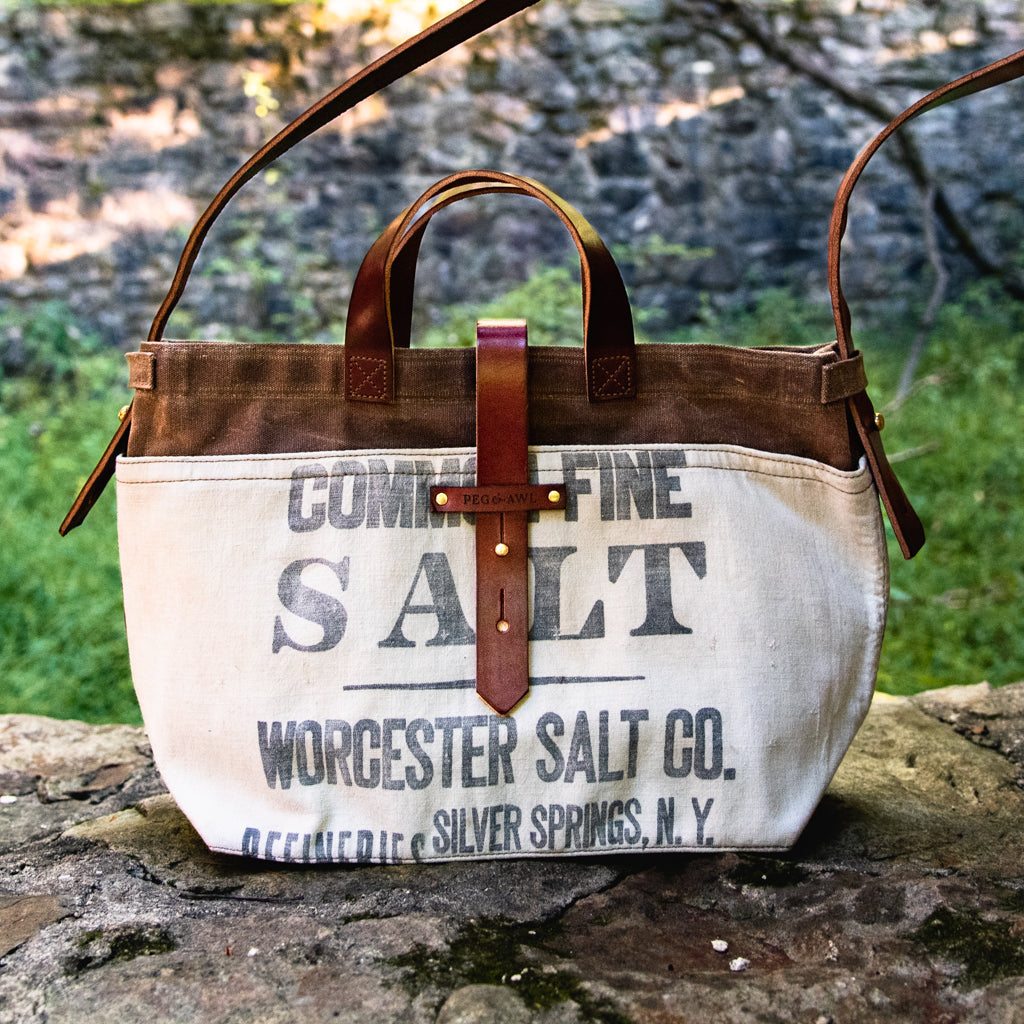

Standard Tote with Vintage Canvas: Salt The vintage textile is on the front pocket – the rest is our Truffle waxed canvas. 

These chickens might be my favourite! Standard Tote with Vintage Canvas: Chicken 
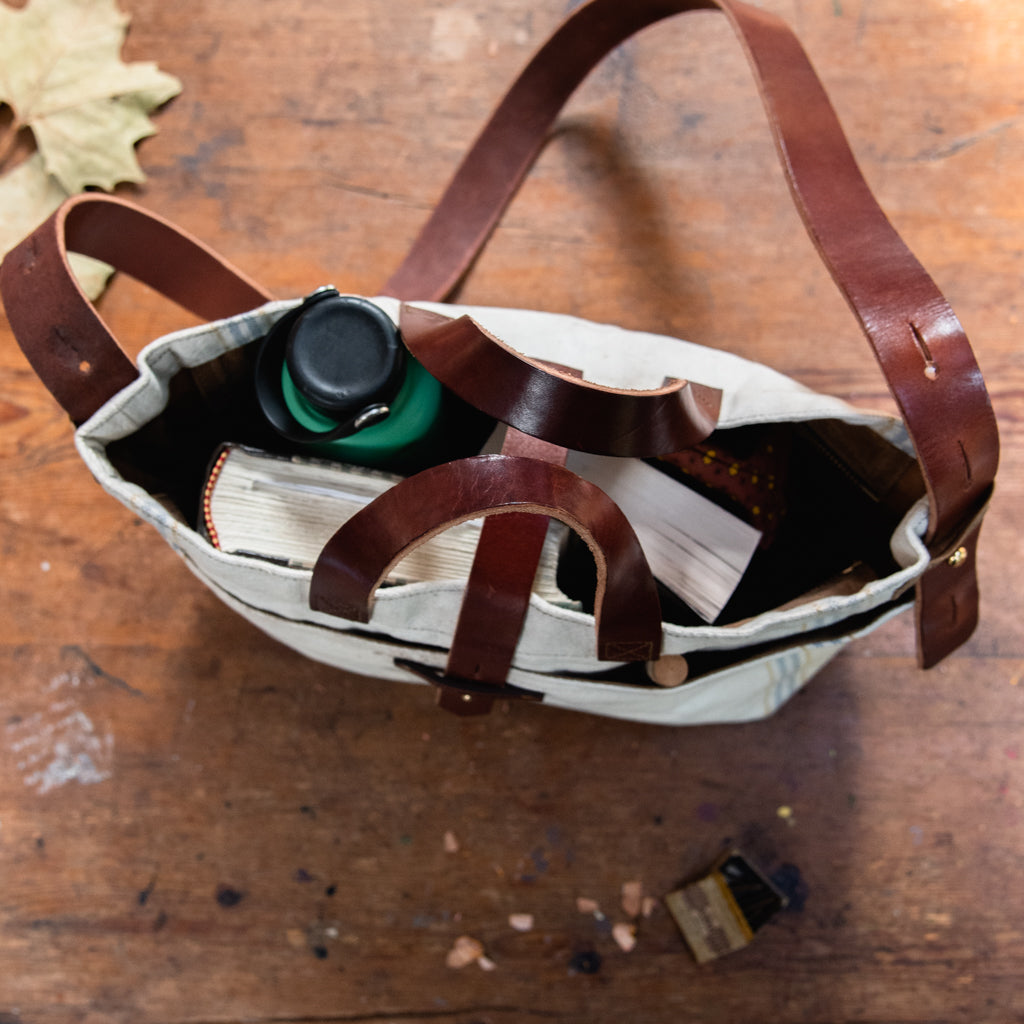
Standard Tote with Vintage Canvas: Fulton No. 1 Inside the tote! 

A view of the inside pockets, showing the lightweight spice waxed canvas! I love the repairs and added character! Vintage Textile Pouches!
It is hard to resist old printed cottons and feedsacks from the early 1900s on flea market tables. We’ve transformed the gathering of patchwork and scrap into useful pouches, giving them new life.


We’ve constructed pouches in shades of feuille morte! Russets and Rosies, Goldenrods and Evergreen, still vibrant, though the textiles are nearly a century old! 

Essentials Pouch with 1930s Textile: Adlai Spender Pouch with 1930s Feedsack: Tamar 

Keeper Pouch with 1940s Textile: Orah Keeper Pouch with 1930s Textile: Ariel Alternative Sketchbooks!
Ginger Tin!
This vintage Ginger Tin makes a great alternative sketchbook for small projects. We’ve filled them with 100 sheets of laser cut Strathmore Drawing paper. Put the tin in the outside pocket of a Sendak, or a pouch, and head out to draw! The portability makes sketching ever-accessible, and the shape makes a good drawing feel complete!
I've been using my Ginger Tin for paint for years, but a new project lead to another idea... Tear or Seed? Read the story on Substack! Cloverine Alternative Sketchbooks!
We are excited to offer a handful of vintage Cloverine Alternative Sketchbooks in this Collection! Each tin comes with 200 sheets of Fabriano hot press watercolour paper. These morsels fit inside the Sendak, making sure you always have some of the finest paper on hand! Additional packs of pre-cut paper can be ordered separately or as an add-on.
Cloverine Alt Sketchbook We will have some packs of water colour paper that fit the Cloverine Alt Sketchbook! Sneak Peek into Our Autumn 2022 Of a Kind Collection!
Small Hunter Satchel incorporating an antique bank bag! Patchi...
Read The Post -
The world is bursting with magic, and for anyone looking, it positively pulses. As a family of life-long learners, we felt compelled to share a few of our favorite activities in one compact notebook of removable cards.
The world is bursting with magic, and for anyone looking, it positively pulses. As a family of life-long learners, we felt compelled to share a few of our favorite activities in one compact notebook of removable cards.
The Specimen Card Notebook
Whether embarking on a backyard exploration, a community science project, traveling near or far, or identifying mysterious objects around your house, these cards encourage observation, drawing, writing, and a touch of research.
Tear them out, and hang them up, give them as gifts, or keep them intact as a journal. However you use them, we hope they inspire you to always keep an eye out for the little things!Specimen Card Notebook
The world is bursting with magic, and for anyone looking, it positively puls...
Read The Post -
The secret to a good Flea Day is a good friend. This past weekend's Flea Day was with Claire Rosen, one of the sisters behind the Warwick Furnace Farm – down the road a piece in Chester County.
 Photographs by Claire Rosen
Photographs by Claire Rosen
The secret to a good Flea Day is a good friend.
This past weekend's Flea Day was with Claire Rosen, one of the sisters behind the Warwick Furnace Farm – down the road a piece in Chester County. Claire days arrive with neither responsibility, nor sense of time. I abandon my life, my family, my Pearl, the dishes and laundry. I abandon the gardening and the weeding. (I don’t abandon Peg and Awl, as it goes). On these days hearts beat in old things, through camera lenses, dress-up, abandoned houses, time behind us and time in front of us, and somehow also, extra now, ever-present. Claire days are all story, all art, all magic.
I awoke early, scribbled small nothings into my journal, then headed out to The Farm to fetch Claire on one of the hottest stickiest summer days. We planned to get there early, while the air was breath-inable. My music is loud for the time of day, but the space betwixt houses, betwixt farms, vibrating with bird and insect chatter, welcomed the intrusion.
When I arrive I step back in time. And here comes Claire in her long flowing dress, with a gigantic woven basket in one hand, wearing the enthusiastic grin of an adventurer.
We drive into excess, into time travel, into a dreamland. We are new friends, but I imagine we will never run out of things to talk about. Everything we find is to become something else. A part of a photograph, a part of our homes, or transformed into a usable entirely other, treasure. We lingered at Leonard's table first, unfolding and refolding seed bags used over and over until disposable bags replaced them in the 1960s. Leonard's were washed and faded and soft. He couldn't hear very well so we had to get extra close or raise our voices to communicate. He smiled a gentle smile with each shout. Claire found some miniature antique frames for an upcoming project. We found dip pens and nibs and new old clothes that fit! Somedays yield no treasures, but I think the company, and the lingering, and the longer looks are what lead to magic.
Each time our bags grew too heavy to hold, we emptied their contents into the truck and went to another place, and another. By the time we returned to The Farm, the truck was full inside and out with tiny treasures to large pieces of furniture and all of the in-betweens. We emptied truck and cleared an antique table of its nests and taxidermy, books — a multitude of treasures. We swiped bits of the long abandoned bird homes and other debris onto the floor in a frenzy, and set out the day's abundance.
We photographed and dreamed of the next adventure before this one was even over. It was dark out before we realised how little we'd eaten all day. Another joy is being so absorbed in a thing, that nourishment is forgotten. We went into Claire's house (a story for another time), into her cozy kitchen and she made Kite Hill tortellinis to which we added a fancy olive oil (Dolly's) and black smoked salt. As Claire melted into her kitchen table, I got my second wind. The nighttime air was cool again, it was nearly tomorrow. I took off playing Asaf Avidam, and drove home amongst lightening bugs, passed a nighttime fox, and returned home to my family playing a late night game of Querkel.
I emptied the day's finds into the already overflowing kitchen, along with my stories from the day...


A rainbow of antique Dip Pens, and this fox embroidery which I will hang up in our house. I have to replace the nibs and clean the pens. Leonard tagged them in 1993! So the stickers are gooey. Next time I may invite myself into the massive warehouse he described with wide but tired eyes. He has been collecting things for 60 years. 

Finding Antique Clothing that fits me is rare! This mother of pearl pen writes like a dream and the other niblets will make their way into something or other. This little kitty detail from a feedsack is SO good. I think I will find a way to incorporate it into a bag! 

These bundle scraps are always a favourite – we use them to line our journals! These are from the early 1900s. This is some of Claire's loot. The pen nibs and seed bags are scrumptious! and the other morsels will be part of some new photographs! 

If the old thread is strong enough, it may find its way into projects. The pen nibs were abundant! I contemplated this 1950s or 60s bear pencil holder for a while — so happy I got 'er! 

Stacks of Feedsacks and Bags that once held Seeds, Sugar, and Salt. These blues will be saved for our Winter Of A Kind collection. Mostly from the 1930s! Working these into our Autumn collection. Any specific dreams? Let us know in the comments! The Secret to a Good Flea (Market) Day is a Good Friend!
Photographs by Claire Rosen The secret to a good Flea Day is a good friend...
Read The Post -

The Scout Plein Air Box was inspired by our endeavor to make art every day. Each one is handmade in our Philadelphia workshop. Watch our video showing how we make the Scout Plein Air Box!
The Scout Plein Air Box was inspired by our endeavor to make art every day. Each one is handmade in our Philadelphia workshop. It compactly secures all of your essential art supplies for painting outdoors. Fill your box with your favorite colors, paintbrushes, and sketchbook. Find your spot and quickly transform the box into a mini studio. Set it on a flat surface or mount it on a tripod, snap the liquid jars, brush holder, and easel in place, clip on your canvas and you are ready to paint. Watch our video showing how we make the Scout Plein Air Box!
Original Plein Air Oil Paintings by Walter Kent
“It has been nearly three years since I returned from a painting workshop in Italy, taught by Jeremy Mann and Nadezda, hosted by Art Escape Italy. This was my first experience plein air painting and once I returned home I immediately made my own pochade box, the Scout. During the last three years I have gone out on many painting adventures, both alone and with my family, with the Scout over my shoulder.
When I wander out into the world to paint, there is a game of tug of war twisting knots in my stomach, with my hopes and fears digging their heals in on either side. After the first few strokes of paint, the excitement of possibility takes over. These attempts at capturing the fleeting moments of the world around me line the windowsills of our studio.I’ve selected some of my favorite Plein Air oil paintings, breadcrumbs of my path as an artist, and we are excited to share them with the everyone. Each painting has been varnished for protection and is signed and marked with its location and date and is fitted with a ready-to-hang frame made of reclaimed blackened walnut.” –Walter
Indian Lake, New York 2022 Shaw’s Bridge, Pennsylvania 2021 Delaware Water Gap No. 3, Pennsylvania 2021
Barnegat Bay, New Jersey 2020 Starr Farm, Pennsylvania 2021 Kaaterskill Falls, New York 2022
Lake Superior, Wisconsin 2020 Kerhonkson, New York 2022 Ready-to-Hang frames are made of reclaimed blackened walnut.
How We Make the Scout Plein Air Box and Original Paintings by Walter Kent
The Scout Plein Air Box was inspired by our endeavor to make art every day....
Read The Post









 Mini Waxed Canvas Tote
Mini Waxed Canvas Tote 























